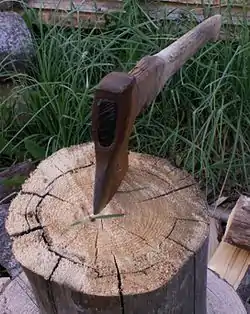斧
| ||||||||
Translingual
Han character
斧 (Kangxi radical 69, 斤+4, 8 strokes, cangjie input 金大竹一中 (CKHML), four-corner 80221, composition ⿱父斤)
References
- Kangxi Dictionary: page 479, character 8
- Dai Kanwa Jiten: character 13539
- Dae Jaweon: page 838, character 4
- Hanyu Da Zidian (first edition): volume 3, page 2023, character 10
- Unihan data for U+65A7
Chinese
| simp. and trad. |
斧 | |
|---|---|---|
Glyph origin
Phono-semantic compound (形聲/形声, OC *paʔ) : phonetic 父 (OC *paʔ, *baʔ) + semantic 斤 (“axe”)
Etymology
From Proto-Sino-Tibetan *r-pʷa (“axe”) (STEDT). Cognate with Garo rua (“axe”), Jingpho nwa, ningwa (“axe”), Tangut 𘟬 (*wjị¹, “axe”), Japhug tɯrpa (“axe”).
Pronunciation
Synonyms
Compounds
- 伐性之斧
- 刀切斧砍
- 刀斧手 (dāofǔshǒu)
- 大刀闊斧/大刀阔斧 (dàdāokuòfǔ)
- 大斧 (dàfǔ)
- 大斧劈
- 小斧劈
- 弄斧班門/弄斧班门
- 投斧
- 提刀弄斧
- 操斧伐柯
- 斤斧
- 斧依
- 斧冰
- 斧削
- 斧子 (fǔzi)
- 斧政 (fǔzhèng)
- 斧斤 (fǔjīn)
- 斧柯
- 斧正 (fǔzhèng)
- 斧藻
- 斧質/斧质
- 斧足綱/斧足纲
- 斧鉞/斧钺 (fǔyuè)
- 斧鉞湯鑊/斧钺汤镬
- 斧鑕/斧锧
- 斧鑿/斧凿
- 斧鑿痕/斧凿痕
- 斧頭/斧头 (fǔtóu)
- 板斧 (bǎnfǔ)
- 水斧蟲/水斧虫
- 燭影斧聲/烛影斧声
- 班門弄斧/班门弄斧 (bānménnòngfǔ)
- 石斧
- 破斧
- 砧斧
- 碪斧/砧斧
- 神工鬼斧
- 資斧/资斧
- 開山斧/开山斧
- 開心斧/开心斧
- 鬼斧
- 鬼斧神工 (guǐfǔshéngōng)
Japanese

Etymology 1
| Kanji in this term |
|---|
| 斧 |
| おの Jinmeiyō |
| kun’yomi |
From Old Japanese. Logographically attested in the Man'yōshū as 斧, and phonetically attested in the Nihon Ryōiki with the man'yōgana spelling 乎乃.[1] In turn, from Proto-Japonic *wənə.
Noun
斧 or 斧 • (ono) ←をの (wono) or ヲノ (wono)?
- axe, hatchet
- 1079, Konkōmyō Saishōōkyō Ongi, page 9 (back):
- 斧 乎乃
- Axe: wono
- 1603–1604, Nippo Jisho:[3]
- Vono. ヲノ (斧) または、 Masacari. (鉞) 斧.
- Vono. ヲノ (斧) または、 Masacari. (鉞) 斧.
- Wono. Also masakari. A hatchet.
- 2008 March 15, “アックス・レイダー [Axe Raider]”, in STARTER DECK, Konami:
- オノを持つ戦士。片手でオノを振り回す攻撃はかなり強い。
- Ono o motsu senshi. Katate de ono o furimawasu kōgeki wa kanari tsuyoi.
- An axe-wielding warrior. He swings his axe with only one arm, yet he can deal quite some heavy blows.
- オノを持つ戦士。片手でオノを振り回す攻撃はかなり強い。
Etymology 2
| Kanji in this term |
|---|
| 斧 |
| よき Jinmeiyō |
| irregular |
Attested in the Shinsen Jikyō of circa 898-901 CE, with the man'yōgana spelling 与支.[4] Presumably from Proto-Japonic, but the first attestation in Japanese is too late to precisely reconstruct the vowels. Cognate with Proto-Ryukyuan *yoki.
Despite widespread regional attestations, the lack of pitch accent information in standard Japanese could imply that this word is not used in modern standard Japanese.
Pronunciation
- (Toyama, Nagano, Gifu, Shizuoka, Aichi (Nagoya), Tottori, Shimane (Izumo), Okayama (Takamatsu)) よき [yòkí] (Heiban – [0])[5] The following dialects listed are Tokyo-type dialects. For more dialectial and accentual data, please consult the source.
- IPA(key): [jo̞kʲi]
Noun
斧 • (yoki)
Usage notes
This term had apparently referred to a small type of hatchet. Depending on the dialect however, it can also refer to a big type of hatchet.
Derived terms
- 斧琴菊 (yokikotokiku, “a traditional dyeing pattern”)
Further reading
- “よき【斧】”, in 日本方言大辞典 (Nihon Hōgen Daijiten, “Nihon Hōgen Daijiten”)
 (in Japanese), Tōkyō: Shogakukan, 1989, released online 2016, →ISBN
(in Japanese), Tōkyō: Shogakukan, 1989, released online 2016, →ISBN
References
- Omodaka, Hisataka (1967) 時代別国語大辞典 上代編 [The dictionary of historical Japanese: Old Japanese] (in Japanese), Tōkyō: Sanseidō, →ISBN, page 837
- “おの[をの] 【斧】”, in 日本国語大辞典 (Nihon Kokugo Daijiten, “Nihon Kokugo Daijiten”)
 (in Japanese), 2nd edition, Tōkyō: Shogakukan, 2000, released online 2007, →ISBN, concise edition entry available here (Note: Dialectal meanings, etymological theories, pronunciation including modern, dialectal, and historical information, Jōdai Tokushu Kanazukai, historical dictionaries containing this word, and the kanji spellings in those dictionaries have been omitted.)
(in Japanese), 2nd edition, Tōkyō: Shogakukan, 2000, released online 2007, →ISBN, concise edition entry available here (Note: Dialectal meanings, etymological theories, pronunciation including modern, dialectal, and historical information, Jōdai Tokushu Kanazukai, historical dictionaries containing this word, and the kanji spellings in those dictionaries have been omitted.) - Doi, Tadao (1603–1604) Hōyaku Nippo Jisho (in Japanese), Tōkyō: Iwanami Shoten, published 1980, →ISBN.
- “よき 【斧】”, in 日本国語大辞典 (Nihon Kokugo Daijiten, “Nihon Kokugo Daijiten”)
 (in Japanese), 2nd edition, Tōkyō: Shogakukan, 2000, released online 2007, →ISBN, concise edition entry available here (Note: Dialectal meanings, etymological theories, pronunciation including modern, dialectal, and historical information, Jōdai Tokushu Kanazukai, historical dictionaries containing this word, and the kanji spellings in those dictionaries have been omitted.)
(in Japanese), 2nd edition, Tōkyō: Shogakukan, 2000, released online 2007, →ISBN, concise edition entry available here (Note: Dialectal meanings, etymological theories, pronunciation including modern, dialectal, and historical information, Jōdai Tokushu Kanazukai, historical dictionaries containing this word, and the kanji spellings in those dictionaries have been omitted.) - Hirayama, Teruo (平山 照男), Ōshima Ichirō (大島 一郎), Ōno Masao (大野 眞男), Kuno Makoto (久野 眞), Kuno Mariko (久野 マリ子), Sugimura Takao (杉村 孝夫) (1992-1994) 現代日本語方言大辞典 [Dictionary of Japanese Dialects], Tokyo: Meiji Shoin (明治書院), pages 911-914
- Tsukishima, Hiroshi (1079) Kojisho Ongi Shūsei 12: Konkōmyō Saishōōkyō Ongi (in Japanese), Tōkyō: Kyūko Shoin, published 1979, →ISBN.
Korean
Hanja
斧 • (bu) (hangeul 부)
- This term needs a translation to English. Please help out and add a translation, then remove the text
{{rfdef}}.